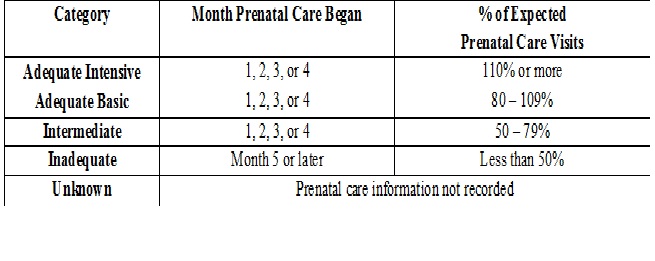Antenatal care utilisation among low-risk and high-risk pregnant women & its effects on pregnancy outcome
Abstract
Objective: To identify the level of utilisation of prenatal services amongst varying risk mothers, to study the factors associated with prenatal care utilisation & to study the association between level of prenatal care utilisation amongst high & low risk women to pregnancy outcome.
Methods: This was a cross sectional study interviewing all the consecutive mothers admitted in post natal ward of the hospital during June July 2018 using a semi structured questionnaire. Mothers not consenting or from whom complete information could not be obtained were excluded from the study. Kotelchuck’s Adequacy of Prenatal Care Utilisation (APNCU) index was used to study utilisation of prenatal care amongst varying risk women & relate it to their pregnancy outcome.
Results: Out of total of 650 women interviewed, 80.76% of them belonged to low risk category & remaining 19.24% were high risk category. 82% of the women had inadequate ANC utilisation. Age, residence or parity had no significant effect on utilisation level of prenatal care. Education positively affected utilisation of prenatal care. The numbers of ultrasound examinations per prenatal visit 0.54 & it was significantly higher in low risk mothers as compared to high risk mothers.
Conclusion: Only less than one fifth of the women had adequate ANC utilisation. High risk women had significantly higher ANC utilisation level as compared to low risk women. Education significantly affected higher utilisation of prenatal care. Overuse of obstetric sonography was observed. Higher chances of low birth weight babies & NICU admissions were observed amongst women with inadequate APNCU index.
Downloads
References
2. WHO. WHO Recommended Interventions for Improving Maternal and Newborn Health ( 2nd edition). Geneva: WHO Department of Making Pregnancy Safer; 2009.
3. [NICE] National Institute for Health and Clinical Excellence. Antenatal care: routine care for the health pregnant woman. London: National Institute for Health and Clinical Excellence; 2008.[pubmed]
4. [AHMAC] Australian Health Ministers’ Advisory Council. Clinical Practice Guidelines: Antenatal Care– Module I. Canberra: Australian Government Department of Health and Ageing 2012. Available from: http://www.health.gov.au/antenatal.
5. [AAP/ACOG] American Academy of Pediatrics and American College of Obstetricians and Gynecologists. Guidelines for Perinatal Care, 7th edition. Washington, DC: American College of Obstetricians and Gynecologists; 2012.
6. VanderWeele T, Lantos J, Siddique J, Lauderdale D. A comparison of four prenatal care indices in birth outcome models: comparable results for predicting small-for-gestational-age outcome but different results for preterm birth or infant mortality. J Clin Epidemiol. 2009; 62(4):438–45. Epub 2008 Oct 22. doi: 10.1016/j.jclinepi.2008.08.001 PMID: 18945589
7. Kotelchuck M. An evaluation of the Kessner Adequacy of Prenatal Care Index and a proposed Adequacy of Prenatal Care Utilization Index. Am J Public Health. 1994 Sep;84(9):1414-20.[pubmed]
8. Joshi C, Torvaldsen S, Hodgson R, et al. Factors associated with the use and quality of antenatal care in Nepal: a population-based study using the demographic and health survey data. BMC Pregnancy Childbirth. 2014 Mar 3;14:94. doi: 10.1186/1471-2393-14-94.[pubmed]
9. Ren Z. Utilisation of antenatal care in four counties in Ningxia, China. Midwifery. 2011 Dec;27(6):e260-6. doi: 10.1016/j.midw.2010.10.016. Epub 2010 Dec 9.[pubmed]
10. Titaley CR1, Dibley MJ, Roberts CL. Factors associated with underutilization of antenatal care services in Indonesia: results of Indonesia Demographic and Health Survey 2002/2003 and 2007. BMC Public Health. 2010 Aug 16;10:485. doi: 10.1186/1471-2458-10-485.[pubmed]
11. Krans EE, Davis MM. Preventing Low Birthweight: 25 years, prenatal risk, and the failure to reinvent prenatal care. American Journal of Obstetrics and Gynecology. 2012; 206(5):398–403. doi: 10.1016/j. ajog.2011.06.082 PMID: 21889122
12. Chen XK, Wen SW, Yang Q, et al. Adequacy of prenatal care and neonatal mortality in infants born to mothers with and without antenatal high-risk conditions. Aust N Z J Obstet Gynaecol. 2007 Apr;47(2):122-7. DOI:10.1111/j.1479-828X.2007.00697.x.[pubmed]
13. Raatikainen K, Heiskanen N, Heinonen S. Under-attending free antenatal care is associated with adverse pregnancy outcomes. BMC Public Health. 2007 Sep 27;7:268. DOI:10.1186/1471-2458-7-268
14. Koroukian SM, Rimm AA. The "Adequacy of Prenatal Care Utilization" (APNCU) index to study low birth weight: is the index biased? J Clin Epidemiol. 2002 Mar;55(3):296-305.[pubmed]
15. Yeoh PL, Hornetz K, Dahlui M. et al. Antenatal Care Utilisation and Content between Low-Risk and High-Risk Pregnant Women. PLoS One. 2016 Mar 24;11(3):e0152167. doi: 10.1371/journal.pone.0152167. eCollection 2016.[pubmed]
16. Kishowar Hossain AH. Utilization of antenatal care services in Bangladesh: an analysis of levels, patterns, and trends from 1993 to 2007. Asia Pac J Public Health. 2010 Oct;22(4):395-406. doi: 10.1177/1010539510366177. Epub 2010 May 24.[pubmed]
17. Mubuuke AG, Malwadde EK, Businge F, Byanyima RK. Utilisation of obstetric sonography at a peri-urban health centre in Uganda. Pan African Medical Journal. 2011; 7:24
18. Thompson E, Freake D, Worrall G. Are rural general practitioner – obstetricians performing too many prenatal ultrasound examinations? Evidence from western Labrador. CAN MED ASSOC J . 1998; 158 (3):307-13
19. Akhan SE, Nadirgil G, Tecer A, et al. The quality of antenatal care in Turkey and the role of ultrasonography in the antenatal care system. Arch Gynecol Obstet. 2003 Apr;268(1):9-14. Epub 2002 Aug 10.[pubmed]
20. White DE, Fraser-Lee NJ, Tough S, et al. The content of prenatal care and its relationship to preterm birth in Alberta, Canada. Health Care Women Int. 2006 Oct;27(9):777-92. DOI:10.1080/07399330600880335.[pubmed]
21. Petrou S, Kupek E, Vause S, et al. Antenatal visits and adverse perinatal outcomes: results from a British population-based study. Eur J Obstet Gynecol Reprod Biol. 2003 Jan 10;106(1):40-9.[pubmed]
22. Handler A, Rankin K, Rosenberg D, Sinha K. Extent of documented adherence to recommended prenatal care content: provider site differences and effect on outcomes among low-income women. Maternal And Child Health Journal. 2012; 16(2):393–405. doi: 10.1007/s10995-011-0763-3
23. Khatun, S., & Rahman, M. (2008). Quality of antenatal care and its dose-response relationship with birth weight in a maternal and child health training institute in Bangladesh. Journal of Biosocial Science. 2008; 40, 321–337.

Copyright (c) 2018 Author (s). Published by Siddharth Health Research and Social Welfare Society

This work is licensed under a Creative Commons Attribution 4.0 International License.


 OAI - Open Archives Initiative
OAI - Open Archives Initiative



















 Therapoid
Therapoid

